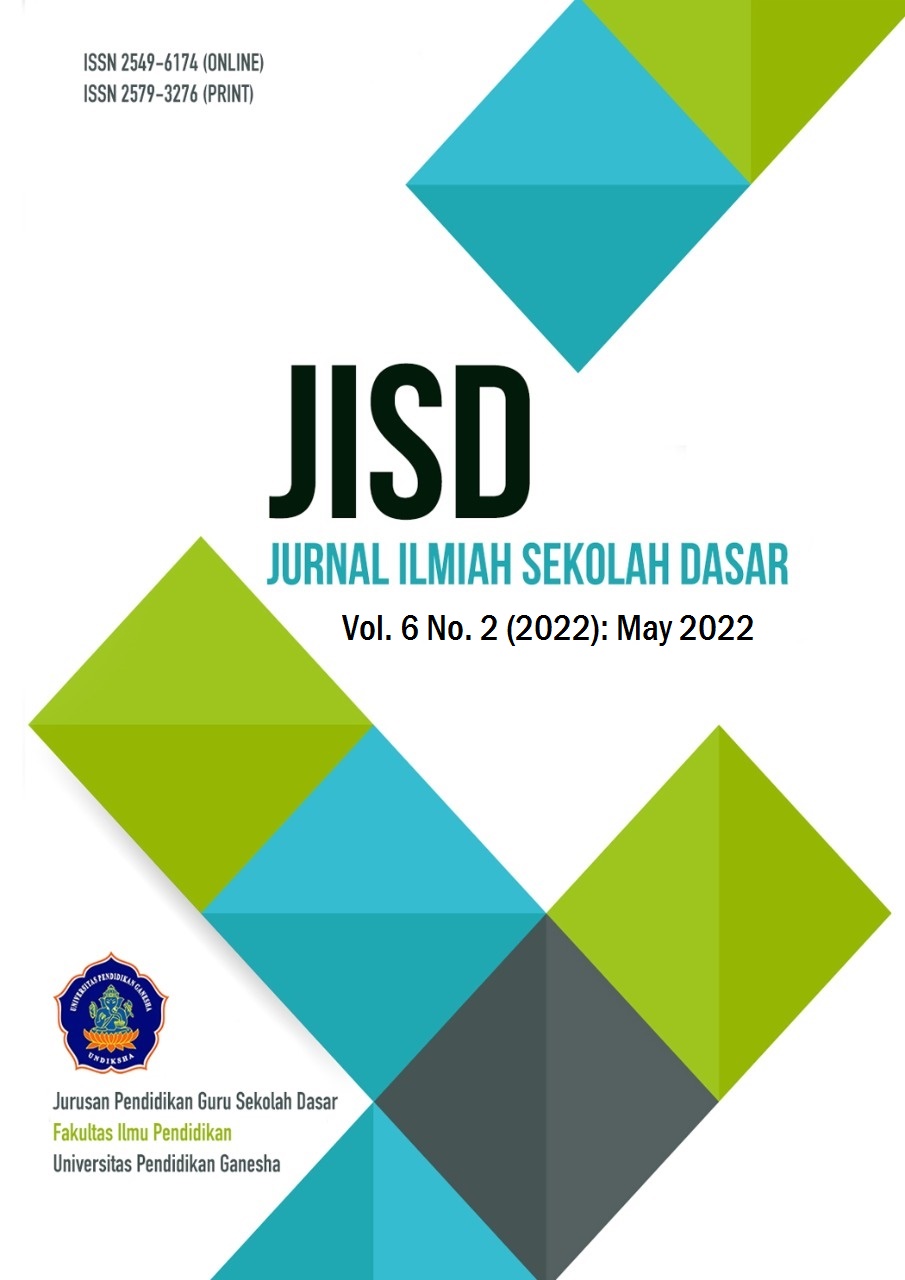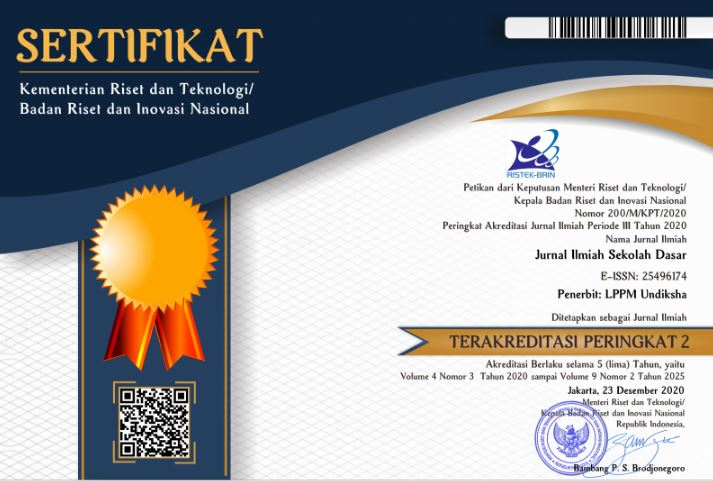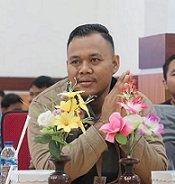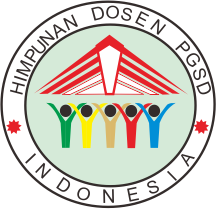Gender and Educational Level: Analysis of Elementary School Teacher Numerical Skills
DOI:
https://doi.org/10.23887/jisd.v6i2.42501Keywords:
Literacy Numeracy, Test Instrument, TeacherAbstract
Various professions demand numeracy skills of at least level 3, including the teaching profession, but teacher numeracy ability data is currently not available. Numeracy is the ability to apply mathematical concepts to make decisions. This research aims to assess the numeracy ability of elementary school teachers based on gender and teacher education level. The school can use data on teacher numeracy skills to evaluate the implementation of numeracy literacy programs in schools. In this study, use a descriptive approach. A total of 27 primary school teachers were the subject of the study. Data collection used general and advanced numeracy test instruments, with 10 questions divided into 3 general numeracy questions and 7 advanced numeracy questions. The collected data was analyzed using descriptive statistical techniques by calculating frequency, average, and data trends. The study results were then presented in the form of a histogram and narrated. The result of this study was the numeracy ability of elementary school teachers classified as moderate. Female teachers have better numeracy skills than men. Teachers with S2 education levels have better numeracy skills than those with S1 education levels. Teacher numeracy skills need to be improved, especially in male teachers who have lower than female teachers. Professional development of teachers in the field of teacher numeracy literacy needs to be improved, and the development of numeracy literacy tests was required in order to measure teacher numeracy skills.
References
Aini, K. N. (2017). Proses berpikir mahasiswa laki-laki dan perempuan dengan gaya kognitif field independent dalam memecahkan masalah. Inspiramatika, 3(1), 16–23. https://doi.org/10.52166/inspiramatika.v3i1.166.
Alberta. (2013). Literacy and Numeracy Progressions. Alberta Education. https://education.alberta.ca/literacy-and-numeracy/.
Alhamid, T., & Anufia, B. (2019). Resume: Instrumen Pengumpulan Data. https://doi.org/https://doi.org/10.31227/osf.io/s3kr6. DOI: https://doi.org/10.31227/osf.io/e56xs
Anas, M., Muchson, M., Sugiono, & Forijati, R. (2021). Pengembangan kemampuan guru ekonomi di Kediri melalui kegiatan pelatihan asesmen kompetensi minimum (AKM). Rengganis Jurnal Pengabdian Masyarakat, 1(1), 48–57. https://doi.org/10.29303/rengganis.v1i1.28. DOI: https://doi.org/10.29303/rengganis.v1i1.28
Anderha, R. R., & Maskar, S. (2021). Pengaruh Kemampuan Numerasi dalam Menyelesaikan Masalah Matematika terhadap Prestasi Belajar Mahasiswa Pendidikan Matematika. Jurnal Ilmiah Matematika Realistik, 2(1), 1–10. https://doi.org/10.33365/ji-mr.v2i1.774. DOI: https://doi.org/10.33365/ji-mr.v2i1.774
Atasoy, R., & Güçlü, N. (2020). Evaluation of Numeracy Skills of Adults According to the Results of PIAAC 2015 in Turkey. World Journal of Education, 10(2), 27. https://doi.org/10.5430/wje.v10n2p27. DOI: https://doi.org/10.5430/wje.v10n2p27
Ayuningtyas, N., & Sukriyah, D. (2020). Analisis pengetahuan numerasi mahasiswa matematika calon guru. Delta-Pi: Jurnal Matematika Dan Pendidikan Matematika, 9(2), 237–247. https://doi.org/10.33387/dpi.v9i2.2299. DOI: https://doi.org/10.33387/dpi.v9i2.2299
Baiduri. (2019). Strategi Literasi dalam Pembelajaran Matematika Pada Era Industri 4.0. MUST: Journal of Mathematics Education, Science and Technology, 4(1), 77–94. http://eprints.umm.ac.id/id/eprint/53232. DOI: https://doi.org/10.30651/must.v4i1.2782
Basri, H., Kurnadi, B., Tafriliyanto, C. F., Bayu, P., Madura, U., & Kotabumi, U. M. (2021). Investigasi Kemampuan Numerasi Mahasiswa Calon Guru Matematika. Jurnal Penelitian Matematika Dan Pendidikan Matematika, 4(2), 72–79. https://doi.org/10.30605/proximal.v4i2.1318. DOI: https://doi.org/10.30605/proximal.v4i2.1318
Batubara, H. H., & Ariani, D. N. (2018). Implementasi Program Gerakan Literasi Sekolah di Sekolah Dasar Negeri Gugus Sungai Miai Banjarmasin. JPSD, 4(1), 15–29. https://doi.org/10.30870/jpsd.v4i1.2965. DOI: https://doi.org/10.30870/jpsd.v4i1.2965
Borgonovi, F., Choi, A., & Paccagnella, M. (2021). The evolution of gender gaps in numeracy and literacy between childhood and young adulthood. In Economics of Education Review (No. 184). https://doi.org/10.1016/j.econedurev.2021.102119. DOI: https://doi.org/10.1016/j.econedurev.2021.102119
Buranda, M. S., & Bernard, M. (2018). Analisis Kemampuan Pemecahan Masalah Matematik Materi Lingkaran Siswa SMP Berdasarkan Gender. Jurnal Pembelajaran Matematika Inovatif, 1(1), 33–40. https://doi.org/10.22460/jpmi.v2i1.p33-40. DOI: https://doi.org/10.22460/jpmi.v2i1.p33-40
Cook, R. (2018). Gender differences in adult numeracy skills : what is the role of education ? Educational Research and Evaluation. https://doi.org/10.1080/13803611.2018.1540992. DOI: https://doi.org/10.1080/13803611.2018.1540992
Ekowati, D. W., Astuti, Y. P., Utami, I. W. P., Mukhlishina, I., & Suwandayani, B. I. (2019). Literasi Numerasi di SD Muhammadiyah. ELSE (Elementary School Education Journal) : Jurnal Pendidikan Dan Pembelajaran Sekolah Dasar, 3(1), 93. https://doi.org/10.30651/else.v3i1.2541. DOI: https://doi.org/10.30651/else.v3i1.2541
Fiangga, S., Amin, S. M., Khabibah, S., Ekawati, R., & Prihartiwi, N. R. (2019). Penulisan Soal Literasi Numerasi bagi Guru SD di Kabupaten Ponorogo. Jurnal Anugrah, 1(1), 9–18. https://doi.org/10.31629/anugerah.v1i1.1631. DOI: https://doi.org/10.31629/anugerah.v1i1.1631
Ginet, L., Itzkowich, R., & Maloney, E. (2018). Math Anxiety and Math Performance : How do they relate ? In Growing Mathematical Minds (1st editio, pp. 173–199). Routledge. https://doi.org/10.4324/9781315646497. DOI: https://doi.org/10.4324/9781315646497-7
Ginsburg, L., Manly, M., & Schmitt, M. J. (2006). The Components of Numeracy. In NCSALL Occasional Paper (MA 02138). https://eric.ed.gov/?id=ED495440.
Hango, D. (2014). University graduates with lower levels of literacy and numeracy skills. Statistic Canada, 75. http://www.statcan.gc.ca/pub/75-006-x/2014001/article/14094-eng.htm.
Hardani, Andriani, H., Ustiawaty, J., Utami, E. F., Istiqomah, R. R., Fardani, R. A., Sukmana, D. J., & Auliya, N. H. (2020). Buku Metode Penelitian Kualitatif & Kuantitatif (H. Abadi (ed.); 1st ed.). Pustaka Ilmu Group.
Harifa, A. C., Hanggara, I., & Sholeh, M. (2021). Pendirian Taman Baca Masyarakat Sebagai Upaya Peningkatan Literasi. Jurnal Pengabdian Kepada Masyarakat, 1(6), 1157–1164. http://bajangjournal.com/index.php/J-ABDI.
Hendrawati, N. E., Muttaqin, N., & Susanti, E. (2020). Etnomatematika : Literasi Numerasi Berdasarkan Bahasa pada Suku Kowai Kabupaten Kaimana. Prosiding SI MaNIs (Seminar Nasional Integrasi Matematika Dan Nilai-Nilai Islami), 3(1), 239–243. http://conferences.uin-malang.ac.id/index.php/SIMANIS/article/view/948.
Hidayat, M. H., Basuki, I. A., & Akbar, S. (2018). Gerakan Literasi Sekolah di Sekolah Dasar. Jurnal Pendidikan, 3(2017), 810–817. https://doi.org/10.17977/jptpp.v3i6.11213.
Indriyani, V., Zaim, M., Atmazaki, & Ramadhan, S. (2019). Literasi Baca Tulis dan Inovasi Kurikulum Bahasa. KEMBARA: Jurnal Keilmuan Bahasa, Sastra, Dan Pengajarannya, 5(1), 108–118. https://doi.org/10.22219/kembara.v5i1.7842. DOI: https://doi.org/10.22219/KEMBARA.Vol5.No1.108-118
Lestari, F. D., Ibrahim, M., Ghufron, S., & Mariati, P. (2021). Pengaruh Budaya Literasi terhadap Hasil Belajar IPA di Sekolah Dasar. Research &Learningin Elementary Education, 5(6), 5087–5099. https://doi.org/10.31004/basicedu.v5i6.1436. DOI: https://doi.org/10.31004/basicedu.v5i6.1436
Lipkus, I. M., Samsa, G., Rimer, B. K., Lipkus, I. M., Samsa, G., & Rimer, B. K. (2001). General Performance on a Numeracy Scale. Medical Decision Making, 21(1), 37–44. https://doi.org/10.1177/0272989X0102100105. DOI: https://doi.org/10.1177/0272989X0102100105
Maghfiroh, F. L., Amin, S. M., Ibrahim, M., & Hartatik, S. (2021). Keefektifan Pendekatan Pendidikan Matematika Realistik Indonesia terhadap Kemampuan Literasi Numerasi Siswa di Sekolah Dasar. JURNAL BASICEDU, 5(5), 3342–3351. https://doi.org/10.31004/basicedu.v5i5.1341. DOI: https://doi.org/10.31004/basicedu.v5i5.1341
Mahmud, M. R., & Pratiwi, I. M. (2019). Literasi Numerasi Siswa Dalam Pemecahan Masalah Tidak Terstruktur. KALAMATIKA Jurnal Pendidikan Matematika, 4(1), 69–88. https://doi.org/10.22236/KALAMATIKA.vol4no1.2019pp69-88. DOI: https://doi.org/10.22236/KALAMATIKA.vol4no1.2019pp69-88
Maloney, E. A., Waechter, S., Risko, E. F., & Fugelsang, J. A. (2012). Reducing the sex difference in math anxiety: The role of spatial processing ability. Learning and Individual Differences, 22(3), 380–384. https://doi.org/10.1016/j.lindif.2012.01.001. DOI: https://doi.org/10.1016/j.lindif.2012.01.001
Maulidina, A. P., & Hartatik, S. (2018). Profil Kemampuan Numerasi Siswa Sekolah Dasar Berkemampuan Tinggi dalam Memecahkan Masalah Matematika. Jurnal Bidang Pendidikan Dasar (JBPD), 3(2), 1–6. https://doi.org/10.21067/jbpd.v3i2.3408. DOI: https://doi.org/10.21067/jbpd.v3i2.3408
Meliyanti, Raraswati, P., Hidayat, D. N., & Aryanto, S. (2021). Kajian Literatur : Perkembangan Literasi dan Numerasi di Lingkungan Keluarga. Jurnal Pendidikan Tambusai, 5(3), 6504–6512. https://doi.org/10.31004/jptam.v5i3.1973.
Mier, H. I. Van, Schleepen, T. M. J., & Berg, F. C. G. Van Den. (2019). Gender Differences Regarding the Impact of Math Anxiety on Arithmetic Performance in Second and Fourth Graders. Front. Psychol, 9(2690), 1–13. https://doi.org/10.3389/fpsyg.2018.02690. DOI: https://doi.org/10.3389/fpsyg.2018.02690
Novak, E., & Tassell, J. L. (2017). Studying preservice teacher math anxiety andmathematics performance in geometry, word, and non-word problem solving. Learning and Individual Differences, 54, 20–29. https://doi.org/10.1016/j.lindif.2017.01.005. DOI: https://doi.org/10.1016/j.lindif.2017.01.005
Nudiati, D., & Sudiapermana, E. (2020). Literasi Sebagai Kecakapan Hidup Abad 21 Pada Mahasiswa. Indonesia Journal of Learning Education and Counseling, 3(1), 34–40. https://doi.org/doi.org/10.31960/ ijolec.v2i2.307. DOI: https://doi.org/10.31960/ijolec.v3i1.561
Nuraeni, D., Uswatun, D. A., & Nurasiah, I. (2020). Analisis Pemahaman Kognitif Matematika Materi Sudut Menggunakan Video Pembelajaran Matematika Sistem Daring di Kelas IV B SDN Pintukisi. Jurnal Ilmiah Pendidikan Dasar, 5(1), 61–75. https://doi.org/10.23969/jp.v5i1.2915. DOI: https://doi.org/10.23969/jp.v5i1.2915
Patriana, W. D., Wulandari, M. D., & Sutama. (2021). Pengelolaan Pembelajaran Berorientasi Literasi Numerasi di Sekolah Dasar dalam Kegiatan Kurikuler dan Ekstrakurikuler. Jurnal Pemikiran Dan Pengembangan Sekolah Dasar, 9(2), 116–131. https://doi.org/10.22219/jp2sd. v9i2.17906.
Perdana, R., & Suswandari, M. (2021). Literasi Numerasi Dalam Pembelajaran Tematik Siswa Kelas Atas Sekolah Dasar. 3(1), 9–15. https://doi.org/10.32585/absis.v3i1.1385. DOI: https://doi.org/10.32585/absis.v3i1.1385
Peters, E. (2012). Beyond Comprehension : The Role of Numeracy in Judgments and Decisions. SAGE, 1(21), 31–35. https://doi.org/10.1177/0963721411429960. DOI: https://doi.org/10.1177/0963721411429960
Primi, C., Donati, M. A., Chiesi, F., & Morsanyi, K. (2018). Are there gender differences in cognitive reflection? Invariance and differences related to mathematics. Thinking and Reasoning, 24(2), 258–279. https://doi.org/10.1080/13546783.2017.1387606. DOI: https://doi.org/10.1080/13546783.2017.1387606
Purpura, D. J., & Lonigan, C. J. (2016). Early Numeracy Assessment: The Development of the Preschool Numeracy Scales. Early Educ Dev., 26(2), 286–313. https://doi.org/10.1080/10409289.2015.991084.Early. DOI: https://doi.org/10.1080/10409289.2015.991084
Ratnasari, E. M. (2020). Outdoor Learning terhadap Literasi Numerasi Anak Usia Dini. Jurnal Inovasi Pendidikan Guru Raudhatul Athfal, 9(2), 183–192. https://doi.org/10.21043/thufula.v8i2.8003. DOI: https://doi.org/10.21043/thufula.v8i2.8003
Retnawati, H. (2016). Analisis Kuantitatif Instrumen Penelitian (1st ed.). Parama Publishing.
Riastini, P. N., Mahayanti, N. W. S., Suryadarma, I., & Wangid, M. N. (2021). Barriers to Elementary School Teachers’ Professional Practice: Teachers’ Voice. İlköğretim Online, 20(1), 1086–1097. https://doi.org/10.17051/ilkonline.2021.01.101. DOI: https://doi.org/10.17051/ilkonline.2021.01.101
Rohim, D. C. (2021). Konsep Asesmen Kompetensi Minimum Meningkatkan Kemampuan Literasi Numerasi Sekolah Dasar untuk Siswa. 54–62. https://doi.org/10.23917/varidika.v33i1.14993. DOI: https://doi.org/10.23917/varidika.v33i1.14993
Rossi, S., Xenidou-Dervou, I., Simsek, E., Artemenko, C., Daroczy, G., Nuerk, H.-C., & Cipora, K. (2021). Mathematics-gender stereotype endorsement influences mathematics anxiety, self-concept, and performance differently in men and women. https://doi.org/10.31234/osf.io/f52zg. DOI: https://doi.org/10.31234/osf.io/f52zg
Sebastião, R. P. A. F. S. (2019). Financial literacy amongst Portuguese students attending higher education on business related courses. http://hdl.handle.net/10400.14/30477.
Siregar, S. (2014). Statistik Parametrik untuk Penelitian Kuantitatif : dilengkapi dengan Perhitungan Manual dan Aplikasi SPSS Versi 17 (F. Hutari (ed.); 1st ed.). PT Bumi Aksara. http://repo.unikadelasalle.ac.id/index.php?p=show_detail&id=7064&keywords=.
Siyoto, S., & Sodik, M. A. (2015). Dasar Metodologi Penelitian (Ayup (ed.); 1st ed.). Literasi Media Publishing.
Sugiyono. (2013). Metode Penelitian Kuantitatif Kualitatif dan R&D (19th ed.). ALFABETA.
Sulistyani, N., & Deviana, T. (2019). Analisis Bahan Ajar Matematika Kelas V SD di Kota Malang. Jurnal Pemikiran Dan Pengembangan Sekolah Dasar, 7(2), 133–141. http://eprints.umm.ac.id/id/eprint/54058.
Suryadarma, D. (2013). Gender differences in numeracy in Indonesia : evidence from a longitudinal dataset. Education Economics, 23(2), 37–41. https://doi.org/10.1080/09645292.2013.819415. DOI: https://doi.org/10.1080/09645292.2013.819415
Westwood, P. S. (2021). Teaching for Numeracy Across the Age Range. Springer. https://doi.org/10.1007/978-981-16-3761-2_6. DOI: https://doi.org/10.1007/978-981-16-3761-2
Williams, C. (2007). Research Methods. Journal of Business & Economic Research, 5(3), 65–72. https://doi.org/10.19030/jber.v5i3.2532. DOI: https://doi.org/10.19030/jber.v5i3.2532
Downloads
Published
How to Cite
Issue
Section
License
Copyright (c) 2022 I Gede Suprawata, Putu Nanci Riastini, Ni Wayan Rati

This work is licensed under a Creative Commons Attribution-ShareAlike 4.0 International License.
Authors who publish with the Journal Ilmiah Sekolah Dasar agree to the following terms:
- Authors retain copyright and grant the journal the right of first publication with the work simultaneously licensed under a Creative Commons Attribution License (CC BY-SA 4.0) that allows others to share the work with an acknowledgment of the work's authorship and initial publication in this journal.
- Authors are able to enter into separate, additional contractual arrangements for the non-exclusive distribution of the journal's published version of the work (e.g., post it to an institutional repository or publish it in a book), with an acknowledgment of its initial publication in this journal.
- Authors are permitted and encouraged to post their work online (e.g., in institutional repositories or on their website) prior to and during the submission process, as it can lead to productive exchanges, as well as earlier and greater citation of published work. (See The Effect of Open Access)










